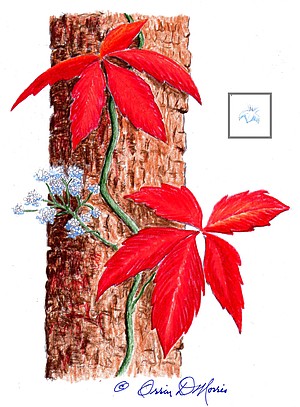
Parthenocissus Quinquefolia
By Orrin Morris
Drought is hard on the wildflower kingdom, as it is on every other facet of nature. The photo for this drawing was taken one fall sunrise in such a year.
Deep in the woods below my house was a mighty white oak that was aglow with red. I got out my digital camera and zoomed in on the sight. As I had expected, it was a Virginia Creeper. The bright red fall leaves of the vine had practically engulfed about 50 feet of the 80-foot tall oak.
I remember the excitement I felt at that moment. Why would such a simple display stir my emotions? Because this plant was defying the negative mood of this extended drought with the message, “Give thanks to the Lord, for He is good; His love endures forever” (Psalm 118:29).
You may know this native wildflower by names other than Virginia creeper, such as woodbine or American ivy. It has a five-leaf cluster as the vine ascends the wall, the fence or a tree. The individual leaves are serrated, as illustrated.
Virginia creeper blooms in July and August. The flowers are tiny and brownish-green so they will not likely adorn anyone’s dinner table.
The real beauty of the Virginia creeper occurs at the onset of the fall colors. In late September or early October, you will notice its brilliant crimson leaves reaching 50 or 60 feet upward on pines and hardwoods whose trunks have a minimum of branches. It does not like deep shade.
On the other hand, Virginia creeper often creeps outward as a ground cover whereby the leaves form a 12-inch “roof” for small animals and birds to hide from predators.
Virginia creeper has at least four claims to fame. First, it is used for erosion control by several states because it does not coexist with kudzu, but strangles it. The second benefit is for wildlife, especially songbirds, who thrive on the small blue fruit.
Third, with careful management, this woody, deciduous vine can be developed as an ornamental on a garden trellis. And finally, the bark has been used by pharmaceuticals to treat dropsy, as a tonic, and as an expectorant, according to John Lust in “The Herb Book.”
“Give thanks to the Lord, for He is good; His love endures forever” (Psalm 118:29).
Rev. Orrin Morris is a retired Baptist pastor, artist and teacher. Find out more about his art and wildflowers on his website.
